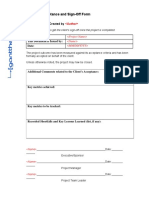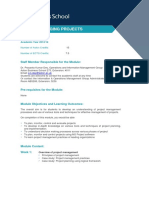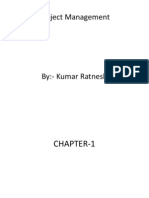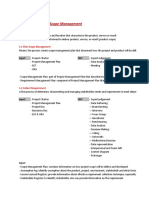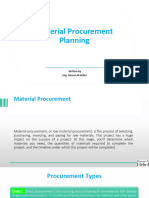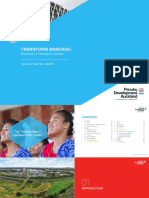Project Execution Introduction
Uploaded by
Mike LassaProject Execution Introduction
Uploaded by
Mike LassaProject Execution - PM Elements
Introduction
Initial Release 1.0
Date: January 1997
What Happens During Once a project in the execution phase, a project team and the necessary
Project Execution? resources should be in place ready to perform the project activities, and the
project plan should have been developed and baselined.
The project team, and specifically the project manager’s focus, now shift from
discovery to participating, observing, and analyzing that what was said would
be done, is being done. This is graphically presented below.
Project Execution
Baseline Plan
Established
Update to
Baseline Done Project is
as Needed Executed
Change Control,
Risk Management Project is Tracked,
and Issue Monitored, and
Identification Done Reviewed
The critical elements for the project management team are to:
• Track and monitor project activities to measure actual performance
to planned performance.
• Review and communicate status and future actions on both a
formal and informal basis.
• Monitor and mitigate potential risks, thus reducing their likelihood
of occurrence
• Establish a change management process to control changes to the
project’s objectives, specifications and overall definition.
• Establish an issue tracking process to ensure that there is a central
repository for project issues that are addressed in a timely fashion.
• Have in place a corrective action process to document and track
plans to correct an issue that impacts the stated plan and to
establish guidelines for re-planning.
Project Management Methodology Project Execution PM Elements Introduction
Page 1
Project Execution - PM Elements
Introduction
Initial Release 1.0
Date: January 1997
Relationship to the The planning processes discussed in the Project Planning section of this
Planning Process document, were conducted to ensure successful implementation of project
activities. The planning process includes a group of related methods and
techniques that provides the basis of defining a detailed list of activities that are
to be completed, and how the work will get done, by whom, when, and for how
much. In summary, the project plan development provides the specifics of:
• WHAT (Objective, scope, and statement of work)
• WHAT-IF (Contingency Plans)
• HOW (Development approach, work breakdown, processes and
procedures)
• WHO (Project organization and resource schedule)
• WHEN (Schedule and milestones)
• WHERE (Facilities required)
The planning process is graphically presented on the next page.
Project Management Methodology Project Execution PM Elements Introduction
Page 2
Project Execution - PM Elements
Introduction
Initial Release 1.0
Date: January 1997
Overview of Planning Process
State of California
Problem Statement
Project Structure
Phase/Act/Task Deliverables
Phase/Act/Task Del Estim
Activity Network Schedule Resource
Approval
DOC
ATP
Project Control Process
Project Management Methodology Project Execution PM Elements Introduction
Page 3
Project Execution - PM Elements
Introduction
Initial Release 1.0
Date: January 1997
Project Control The project plan serves as the basis for the project's monitoring, controlling, and
Process reporting activities. By following the plan and gathering relevant data for the
status meetings and reports, information will be available to accurately identify
issues and problems early, minimize project risks, and monitor, control, and
report progress.
Once a project has been baselined and the project starts, then it needs to be
directed. This next series of documents deals with the “control” of the project
after it has begun. This involves processes that need to be in place to ensure
that the project progresses according to plan. During tracking, monitoring, and
reviewing, the project team collects data to assess the current state of the
project. These activities include:
• Review the completed activities.
• Identify milestones reached.
• Identify problems or issues.
• Update project schedule and progress information.
• Update budget and variances.
Additional project controls are taken, as needed, following an assessment of
actual to planned execution. Project controls include:
• Addressing issues.
• Reviewing change requests and making recommendations.
• Preparing action plans.
• Rescheduling.
• Reallocating resources.
• Adding resources and/or equipment.
The next figure presents a graphic view of the project control process.
Project Control Process
Project Management Methodology Project Execution PM Elements Introduction
Page 4
Project Execution - PM Elements
Introduction
Initial Release 1.0
Date: January 1997
Process Planning
Activity Network
State of California
Project Resources
Schedule
Plan
Issue Items
Action Items
Actuals Status Reports
Tasks Plan Rev Var
Updates
Activity Network
Resources Variances
Schedule
Tasks Plan Rev Act Var
Change and
Project Risk Corrective
Issue
Meetings Monitoring Action
Management
Project Management Methodology Project Execution PM Elements Introduction
Page 5
Project Execution - PM Elements
Introduction
Initial Release 1.0
Date: January 1997
Preventing Problems Projects fail due to inattention to basic control principles. Too many times the
is a Better Course project team is busy getting on with “completing the project” and not spending
the time and energy to anticipate problems. Then, once a problem is suspected,
than Fixing Them the team acts too slowly to resolve the root of the problem.
The reason for these project management methods is to “prevent” project
development problems. Preventing problems is far easier and less costly than
solving them, and the best way to locate a problem is to always be looking for
it. For example, frequent and unchecked changes to the requirements
specifications are a known leading source for design problems. Listed below
are some potential problems that may arise.
• Lack of good data on activity progress.
• Inadequate definition of requirements.
• Frequent and uncontrolled changes to the baselined
requirements.
• Poor time and cost estimates.
• Difficulties in concluding the project because of lack of
completion criteria.
• Frequent replacement of development personnel.
• Inadequate tracking and directing of project activities.
Once a project has started, one of the most common problems is that the project
manager, and possibly the full project team, is unaware of the existence of a
major problem at a stage when it could be contained and corrected. This can be
resolved by the consistent sharing of information and taking action based on
that information.
Which Projects Need The tracking, monitoring, and reviewing processes apply in varying degrees to
all projects: small, medium or large. As in all the sections of this document,
Control? caution should be taken not to use the processes as a “recipe,” but to analyze the
specific project and develop management structures that best meet the needs of
the project. These are suggested guidelines that should be tailored to the
specific project and state organization.
References: Many of the referenced status reports and other documents discussed in the next
series of sections are provided for use in Appendix B: Templates & Sample
Forms.
Project Management Methodology Project Execution PM Elements Introduction
Page 6
You might also like
- Project Client Acceptance and Sign-Off FormNo ratings yetProject Client Acceptance and Sign-Off Form2 pages
- 00 - PMP - Part 01 - Introducing PMP Concept-Handwritten NotesNo ratings yet00 - PMP - Part 01 - Introducing PMP Concept-Handwritten Notes11 pages
- 20 Are There Too Many Lawyers in The PhilippinesNo ratings yet20 Are There Too Many Lawyers in The Philippines5 pages
- Submitted By: Preeti Submitted To: Prof - Tejinder ROLL NO: 18010 Class: Mcom 1St100% (1)Submitted By: Preeti Submitted To: Prof - Tejinder ROLL NO: 18010 Class: Mcom 1St16 pages
- 1 Course Name 2 Candidate Name Ashar Milind Mahesh Rashmi: Module 56/ PGPPMNo ratings yet1 Course Name 2 Candidate Name Ashar Milind Mahesh Rashmi: Module 56/ PGPPM26 pages
- Project Management: Library Renovation Project PlanNo ratings yetProject Management: Library Renovation Project Plan24 pages
- Strategic Planning and Priority Setting: Prepared By: Vanessa J. Dela Cruz Luivie Jhon R. BitonganNo ratings yetStrategic Planning and Priority Setting: Prepared By: Vanessa J. Dela Cruz Luivie Jhon R. Bitongan29 pages
- Bnm808 Managing Projects: Staff Member Responsible For The ModuleNo ratings yetBnm808 Managing Projects: Staff Member Responsible For The Module5 pages
- ITPM - 09-Project Human Resource ManagementNo ratings yetITPM - 09-Project Human Resource Management63 pages
- Assignment Communication and SchedullingNo ratings yetAssignment Communication and Schedulling7 pages
- PJM5900 Week 4 - Project Schedule Management - 2021No ratings yetPJM5900 Week 4 - Project Schedule Management - 202127 pages
- Senior Project Manager or Project Manager or Regional Manager orNo ratings yetSenior Project Manager or Project Manager or Regional Manager or1 page
- Schedule Management Plan Form - PMBOK 6th EditionNo ratings yetSchedule Management Plan Form - PMBOK 6th Edition2 pages
- Putting The Project Pieces Together Project Planning TrainingNo ratings yetPutting The Project Pieces Together Project Planning Training35 pages
- Project Communications Management - Area 7No ratings yetProject Communications Management - Area 730 pages
- Knowledge Area Project Integration Management100% (1)Knowledge Area Project Integration Management3 pages
- An Exploratory Study of Project Success With Tools, Software and MethodsNo ratings yetAn Exploratory Study of Project Success With Tools, Software and Methods18 pages
- Provision of Materials, Fabrication and Offshore Installation For Rba Vent Boom Walkway, Storage Container and Miscellaneous Items Block 01 & 02 Offshore VietnamNo ratings yetProvision of Materials, Fabrication and Offshore Installation For Rba Vent Boom Walkway, Storage Container and Miscellaneous Items Block 01 & 02 Offshore Vietnam6 pages
- Effective Leadership in Project Management Demands On and Profile of Leaders ProgressNo ratings yetEffective Leadership in Project Management Demands On and Profile of Leaders Progress14 pages
- Managing Hospitality and Tourism Project: Submitted byNo ratings yetManaging Hospitality and Tourism Project: Submitted by18 pages
- Using Project Management Office (Pmo) To Improve Project Management AbilitiesNo ratings yetUsing Project Management Office (Pmo) To Improve Project Management Abilities13 pages
- Material Procurement Planning 1704278936No ratings yetMaterial Procurement Planning 170427893635 pages
- Enterprise School Management: Under The Guidence ofNo ratings yetEnterprise School Management: Under The Guidence of47 pages
- Project Schedule Management: Instructor Hamza EjazNo ratings yetProject Schedule Management: Instructor Hamza Ejaz44 pages
- PM2-Methodology - Leaflet.v.2.1.4 18052018 PDFNo ratings yetPM2-Methodology - Leaflet.v.2.1.4 18052018 PDF8 pages
- Project Scope Statement: Project Name: Wi-Fi Garage Door Opener Finish Date: September10No ratings yetProject Scope Statement: Project Name: Wi-Fi Garage Door Opener Finish Date: September101 page
- Project - Management - Syllabus JM BUSA BANo ratings yetProject - Management - Syllabus JM BUSA BA7 pages
- Module 2: Project Management Overview Project Management Overview and DefinitionNo ratings yetModule 2: Project Management Overview Project Management Overview and Definition2 pages
- The Case of The Never Ending Scope Creep Prep100% (1)The Case of The Never Ending Scope Creep Prep13 pages
- PMO Project Kickoff Announcement TemplateNo ratings yetPMO Project Kickoff Announcement Template1 page
- CDC UP Project Management Plan TemplateNo ratings yetCDC UP Project Management Plan Template12 pages
- Nuts and Bolts of Project Management: Right Timing + Right Decision = SuccessFrom EverandNuts and Bolts of Project Management: Right Timing + Right Decision = Success5/5 (1)
- Project Management Methodology: Project Execution - PM ElementsNo ratings yetProject Management Methodology: Project Execution - PM Elements62 pages
- PDF Created With Pdffactory Pro Trial VersionNo ratings yetPDF Created With Pdffactory Pro Trial Version6 pages
- Different Types of Questions Based On BloomNo ratings yetDifferent Types of Questions Based On Bloom3 pages
- Newsletter: Celebrating A Decade of DevelopmentNo ratings yetNewsletter: Celebrating A Decade of Development4 pages
- Powering Ontario For The Next Half-Century: Refurbishing DarlingtonNo ratings yetPowering Ontario For The Next Half-Century: Refurbishing Darlington8 pages
- Metals: Low Cycle Fatigue and Relaxation Performance of Ferritic-Martensitic Grade P92 SteelNo ratings yetMetals: Low Cycle Fatigue and Relaxation Performance of Ferritic-Martensitic Grade P92 Steel25 pages
- Errata To Principles of Heating, Ventilating, and Air ConditioningNo ratings yetErrata To Principles of Heating, Ventilating, and Air Conditioning5 pages
- Saved Case Data Extraction Subroutines PSS®E 35.3.0: July 2021No ratings yetSaved Case Data Extraction Subroutines PSS®E 35.3.0: July 202158 pages
- Choong-Sik Chung - Developing Digital Governance - South Korea As A Global Digital Government Leader-Routledge (2020) - RemovedNo ratings yetChoong-Sik Chung - Developing Digital Governance - South Korea As A Global Digital Government Leader-Routledge (2020) - Removed13 pages
- CBIP Paper-Transformer Standardization - NTPCNo ratings yetCBIP Paper-Transformer Standardization - NTPC4 pages
- The Effect of Synchronous and Asynchronous Participation On Students' Performance in Online Accounting CoursesNo ratings yetThe Effect of Synchronous and Asynchronous Participation On Students' Performance in Online Accounting Courses31 pages
- ACT 203 Cost Accounting: 04/05/2023 B Com (Finance/ Accounting), RTC, ThimphuNo ratings yetACT 203 Cost Accounting: 04/05/2023 B Com (Finance/ Accounting), RTC, Thimphu35 pages
- Orange and Violet Illustration Class Syllabus Education PresentationNo ratings yetOrange and Violet Illustration Class Syllabus Education Presentation5 pages
- Dynamics of Rigid Bodies Part 1 (Edited)No ratings yetDynamics of Rigid Bodies Part 1 (Edited)1 page
- Enforcing Arbitration Awards in CaliforniaNo ratings yetEnforcing Arbitration Awards in California6 pages
- Safety Data Sheet Sds #: Ninjaflex Semiflex: 1. Product and Company IdentificationNo ratings yetSafety Data Sheet Sds #: Ninjaflex Semiflex: 1. Product and Company Identification5 pages
- Product Data Sheet: Easylogic Pm1120H P&E THD RS485 CL 1.0No ratings yetProduct Data Sheet: Easylogic Pm1120H P&E THD RS485 CL 1.04 pages
- 00 - PMP - Part 01 - Introducing PMP Concept-Handwritten Notes00 - PMP - Part 01 - Introducing PMP Concept-Handwritten Notes
- Submitted By: Preeti Submitted To: Prof - Tejinder ROLL NO: 18010 Class: Mcom 1StSubmitted By: Preeti Submitted To: Prof - Tejinder ROLL NO: 18010 Class: Mcom 1St
- 1 Course Name 2 Candidate Name Ashar Milind Mahesh Rashmi: Module 56/ PGPPM1 Course Name 2 Candidate Name Ashar Milind Mahesh Rashmi: Module 56/ PGPPM
- Project Management: Library Renovation Project PlanProject Management: Library Renovation Project Plan
- Strategic Planning and Priority Setting: Prepared By: Vanessa J. Dela Cruz Luivie Jhon R. BitonganStrategic Planning and Priority Setting: Prepared By: Vanessa J. Dela Cruz Luivie Jhon R. Bitongan
- Bnm808 Managing Projects: Staff Member Responsible For The ModuleBnm808 Managing Projects: Staff Member Responsible For The Module
- PJM5900 Week 4 - Project Schedule Management - 2021PJM5900 Week 4 - Project Schedule Management - 2021
- Senior Project Manager or Project Manager or Regional Manager orSenior Project Manager or Project Manager or Regional Manager or
- Putting The Project Pieces Together Project Planning TrainingPutting The Project Pieces Together Project Planning Training
- An Exploratory Study of Project Success With Tools, Software and MethodsAn Exploratory Study of Project Success With Tools, Software and Methods
- Provision of Materials, Fabrication and Offshore Installation For Rba Vent Boom Walkway, Storage Container and Miscellaneous Items Block 01 & 02 Offshore VietnamProvision of Materials, Fabrication and Offshore Installation For Rba Vent Boom Walkway, Storage Container and Miscellaneous Items Block 01 & 02 Offshore Vietnam
- Effective Leadership in Project Management Demands On and Profile of Leaders ProgressEffective Leadership in Project Management Demands On and Profile of Leaders Progress
- Managing Hospitality and Tourism Project: Submitted byManaging Hospitality and Tourism Project: Submitted by
- Using Project Management Office (Pmo) To Improve Project Management AbilitiesUsing Project Management Office (Pmo) To Improve Project Management Abilities
- Enterprise School Management: Under The Guidence ofEnterprise School Management: Under The Guidence of
- Project Schedule Management: Instructor Hamza EjazProject Schedule Management: Instructor Hamza Ejaz
- Project Scope Statement: Project Name: Wi-Fi Garage Door Opener Finish Date: September10Project Scope Statement: Project Name: Wi-Fi Garage Door Opener Finish Date: September10
- Module 2: Project Management Overview Project Management Overview and DefinitionModule 2: Project Management Overview Project Management Overview and Definition
- Nuts and Bolts of Project Management: Right Timing + Right Decision = SuccessFrom EverandNuts and Bolts of Project Management: Right Timing + Right Decision = Success
- Project Management Methodology: Project Execution - PM ElementsProject Management Methodology: Project Execution - PM Elements
- Powering Ontario For The Next Half-Century: Refurbishing DarlingtonPowering Ontario For The Next Half-Century: Refurbishing Darlington
- Metals: Low Cycle Fatigue and Relaxation Performance of Ferritic-Martensitic Grade P92 SteelMetals: Low Cycle Fatigue and Relaxation Performance of Ferritic-Martensitic Grade P92 Steel
- Errata To Principles of Heating, Ventilating, and Air ConditioningErrata To Principles of Heating, Ventilating, and Air Conditioning
- Saved Case Data Extraction Subroutines PSS®E 35.3.0: July 2021Saved Case Data Extraction Subroutines PSS®E 35.3.0: July 2021
- Choong-Sik Chung - Developing Digital Governance - South Korea As A Global Digital Government Leader-Routledge (2020) - RemovedChoong-Sik Chung - Developing Digital Governance - South Korea As A Global Digital Government Leader-Routledge (2020) - Removed
- The Effect of Synchronous and Asynchronous Participation On Students' Performance in Online Accounting CoursesThe Effect of Synchronous and Asynchronous Participation On Students' Performance in Online Accounting Courses
- ACT 203 Cost Accounting: 04/05/2023 B Com (Finance/ Accounting), RTC, ThimphuACT 203 Cost Accounting: 04/05/2023 B Com (Finance/ Accounting), RTC, Thimphu
- Orange and Violet Illustration Class Syllabus Education PresentationOrange and Violet Illustration Class Syllabus Education Presentation
- Safety Data Sheet Sds #: Ninjaflex Semiflex: 1. Product and Company IdentificationSafety Data Sheet Sds #: Ninjaflex Semiflex: 1. Product and Company Identification
- Product Data Sheet: Easylogic Pm1120H P&E THD RS485 CL 1.0Product Data Sheet: Easylogic Pm1120H P&E THD RS485 CL 1.0

